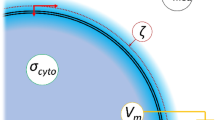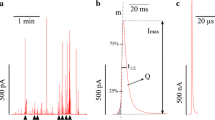Summary
The amount of Ca++ which is bound to the surface of Paramecium can be controlled by the relative concentrations of cations, and determines, in part, the ciliary response to cationic stimuli (Naitoh and Yasumasu, 1967; Naitoh, 1968). Experiments were performed to examine the relationship between cationic concentration and binding on the one hand, and electrical behavior of the cell on the other. Solutions of Ca++, and solutions of calcium plus Mg++, Ba++, K+, Na+ or Rb+were tested at concentrations of 0.06 to 16 mM. In calcium solutions the I-V characteristics were relatively independent of [Ca], while the resting potential dropped with a slope of 20 mV per decade increase in [Ca]. In mixtures of Ca plus other cations I-V characteristics were also relatively independent of ionic concentrations, provided the amount of bound calcium was held constant. The slope resistance in the region of zero current was also dependent on bound calcium, but was somewhat complicated by specific properties of some cationic species. All the cations tested lowered the resting potential, and hence the membrane appears to have poor cation permselectivity. Cationic permeability was largely a function of the degree of saturation of the anionic binding sites with Ca++; with a decrease in bound Ca the conductance to any cation was increased.
Similar content being viewed by others
References
Allen, R. D.: Fine structure, reconstruction and possible functions of components of the cortex of Tetrahymena pyriformis. J. Protozool. 14, 553 (1967).
Bingley, M. S.: Saline-filled microelectrodes in relation to membrane potential measurements in fresh water protozoa. Nature (Lond.) 202, 1218 (1964).
Curtis, B. A.: Some effects of Ca-free choline-Ringer solution on frog skeletal muscle. J. Physiol. (Lond.) 166, 75 (1963).
Fatt, P., and B. L. Ginsborg: The ionic requirements for the production of action potentials in crustacean muscle fibres. J. Physiol. (Lond.) 142, 516 (1958).
Frankenhaeuser, B., and A. L. Hodgkin: The action of calcium on the electrical properties of squid axons. J. Physiol. (Lond.) 137, 218 (1957).
Goldman, D. E.: Potential, impedance and rectification in membranes. J. gen. Physiol. 27, 37 (1943).
Grundfest, H.: Some comparative biological aspects of membrane permeability control. Fed. Proc. 26, 1613 (1967).
Ishiko, N., and M. Sato: The effect of Ca++ on the electrical properties of striated muscle. Jap. J. Physiol. 7, 51 (1957).
Kamada, T.: Some observations on potential differences across the ectoplasm membrane of Paramecium. J. exp. Biol. 11, 94 (1934).
—: Ciliary reversal of Paramecium. Proc. Imp. Acad. (Tokyo) 16, 241 (1940).
Kinosita, H., S. Dryl, and Y. Naitoh: Changes in the membrane potential and the responses to stimuli in Paramecium. J. Fac. Sci., Univ. Tokyo, Sect. IV 10, 291 (1964).
—: Relation between the magnitude of membrane potential and ciliary activity in Paramecium. J. Fac. Sci., Univ. Tokyo, Sect. IV 10, 303 (1964).
—, A. Murakami, and M. Yasuda: Interval between membrane potential change and ciliary reversal in Paramecium immersed in Ba-Ca mixture. J. Fac. Sci., Univ. Tokyo, Sect. IV 10, 421 (1965).
Koketsu, K.: Membrane calcium and bioelectric potentials. In Studies in Physiology (D. R. Curtis and A. K. McIntyre, editors), Berlin-Heidelberg-New York: Springer 1965.
Naitoh, Y.: Reversal response elicited in non beating cilia of Paramecium by membrane depolarization. Science 154, 660 (1966).
—: Ionic control of the reversal response of cilia in Paramecium caudatum: A calcium hypothesis. J. gen. Physiol. 51, 85 (1968).
- Control of the orientation of cilia by ATP, Ca and Zn in glycerol-extracted Paramecium caudatum. J. gen. Physiol., in press (1969).
—, and R. Eckert: Action potential in Paramecium. J. gen. Physiol. 50, 2489 (Abstract) (1967).
—: Electrical properties of Paramecium caudatum: All-or-none electrogenesis. Z. vergl. Physiol. 61, 453 (1968).
—, and I. Yasumasu: Binding of Ca ions by Paramecium caudatum. J. gen. Physiol. 50, 1303 (1967).
Okumura, H., and T. Yamaguchi: Electrical properties of the cell membrane of Paramecium. Zool. Mag. (Tokyo) 71, 157 (1962).
Pitelka, D. R.: Electron-microscopic structure of Protozoa. New York: Macmillan 1963.
Tobias, J. M.: A chemically specified molecular mechanism underlying excitation in nerve: A hypothesis. Nature (Lond.) 203, 13 (1964).
Werman, R., and H. Grundfest: Graded and all-or-none electrogenesis in arthropod muscle, II. The effects of alkali-earth and onium ions on lobster muscle fibers. J. gen. Physiol. 44, 997 (1961).
—, F. V. McCann, and H. Grundfest: Graded and all-or-none electrogenesis in arthropod muscle. I. The effects of alkali-earth cations on the neuromuscular system of Romalea microptera. J. gen. Physiol. 44, 979 (1961).
Yamaguchi, T.: Studies on the modes of ionic behavior across the ectoplasmic membrane of Paramecium. I. Electric potential differences measured by the intracellular microelectrode. J. Fac. Sci., Univ. Tokyo, Sect. IV 8, 573 (1960).
Author information
Authors and Affiliations
Additional information
On leave of absence from the Zoological Institute, Faculty of Science, University of Tokyo.
We gratefully acknowledge the kind help of Dr. H. Grundfest in criticizing the manuscript, and in offering instructive suggestions.
Support came from National Science Foundation grant GB-5752X, U.S.P.H.S. grant NB-03664, and in part from Office of Naval Research grant Nonr 4785(00) administered by the Marine Biological Laboratory.
Rights and permissions
About this article
Cite this article
Naitoh, Y., Eckert, R. Electrical properties of Paramecium caudatum: modification by bound and free cations. Z. Vergl. Physiol. 61, 427–452 (1968). https://doi.org/10.1007/BF00297875
Received:
Issue Date:
DOI: https://doi.org/10.1007/BF00297875




